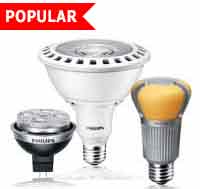Energy Saving Tips: Lighting
Indoor Lighting
Increasing your lighting efficiency is one of the fastest ways to decrease your energy bills. If you replace 25% of your lights in high-use areas with fluorescent, you can save about 50% of your lighting energy bill.
Fluorescent lamps are much more efficient than incandescent bulbs and last 6 to 10 times longer. Although fluorescent and compact fluorescent lamps are more expensive than incandescent bulbs, they pay for themselves by saving energy over their lifetime.
By incorporating these features into your home, you not only use less electricity, but also stay cooler in the summer because less heat is being generated by lights.
Outdoor Lighting
Many homeowners use outdoor lighting for decorations and security. When shopping for outdoor lights, you will find a variety of products, from low-voltage pathway lighting to motion-detector floodlights. Some stores also carry lights powered by small photovoltaic (PV) modules that convert sunlight directly into electricity.
Compact Fluorescent Lighting (CFL) vs. Incandescent Lighting
Incandescent lamps are the most common lighting source in U.S., but they waste the most energy.Ninety percent of the energy consumed by incandescent lamps is given off as heat rather than visible light.Incandescents last for about 750 hours, CFLs 10,000 hours.Compact fluorescent light bulbs are the most efficient light bulbs available today.CFLs are about 75 percent cooler
(source US Department of Energy)
10 Low-Cost Energy-Saving Tips
1. Install water flow restrictors and aerators in sink faucets. These measures can save you money by reducing water use (including hot water).
2. Replace air filters regularly. Replacing a dirty air filter can save money by reducing the amount of time your a/c or furnace stays on.
3. Seal exterior cracks and holes, and ensure tight-fitting windows. Small cracks or holes in the building exterior can really add up to substantial heating or cooling losses.
4. Shade sun-exposed windows and walls. Sunlight streaming through windows can substantially increase your air-conditioning costs. Use shading methods (like sun screens, awnings, and trees) wherever possible.
5. Replace your most frequently used incandescent bulbs with compact fluorescent lights (CFL). CFLs use only about a third as much electricity as standard light bulbs.
6. Replace outdoor lighting with a motion-detector equipped bulb or fixture. Outdoor lights that are left on all night add to your power bill.
7. Install a low-flow shower head. Low-flow shower heads will reduce the amount of hot water you use and the energy needed to heat it.
8. Perform low-cost fireplace modifications. Adding a flue-top damper or glass doors can save energy when the fireplace is not in use.
9. Install programmable thermo-stats. These devices will change the temperature setting when you are not home.
10. Install automatic room-lighting controls. Similar to programmable thermostats, these devices help optimize lighting use by automatically turning lights on or off, depending on occupancy or time of day.
Resources:
- ENERGY STAR
- ENERGY STAR Recycle My Old Fridge Campaign
- EPA's GreenScapes












Comments